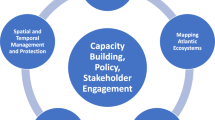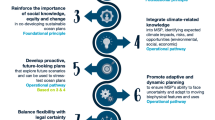Abstract
The pace of environmental change lends urgency to the need for integration of climate considerations into ocean policy and management. A recent rapid expansion of ocean and climate policies provides a timely window of opportunity for the scientific community to inform and support these efforts. Lessons can be learned from successful initiatives, where scientists are working hand-in-hand with decision makers and managers to enhance ocean resilience. Looking ahead, the most pressing decision-needs associated with oceans and climate change should serve to prioritize and drive scientific efforts.
This is a preview of subscription content, access via your institution
Access options
Subscribe to this journal
Receive 12 print issues and online access
$209.00 per year
only $17.42 per issue
Buy this article
- Purchase on Springer Link
- Instant access to full article PDF
Prices may be subject to local taxes which are calculated during checkout

Similar content being viewed by others
References
Millennium Ecosystem Assessment Ecosystems and Human Well-Being: Synthesis (Island Press, 2005).
Food and Agriculture Organization of the United Nations The State of the World Fisheries and Aquaculture 2012 (FAO, 2013).
Economics: National Ocean Watch (ENOW) Explorer (NOAA Coastal Services Center, 2014); http://www.csc.noaa.gov/enow/explorer/
National Oceanic and Atmospheric Administration National Coastal Population Report: Trends from 1970 to 2020 (NOAA, 2013); http://www.stateofthecoast.noaa.gov
Doney, S. C. et al. Climate change impacts on marine ecosystems. Annu. Rev. Mar. Sci. 4, 11–37 (2012).
Halpern, B. S. et al. An index to assess the health and benefits of the global ocean. Nature 488, 615–620 (2012).
Ruckelshaus, M. et al. Securing ocean benefits for society in the face of climate change. Mar. Policy 40, 154–159 (2013).
Borgerson, S. G. Arctic meltdown: the economic and security implications of global warming. Foreign Aff. 87, 63–77 (2008).
Campbell, K. M. et al. The Age of Consequences: The Foreign Policy and National Security Implications of Global Climate Change (Center for Strategic and International Studies and Center for a New American Security, 2007).
Lackenbauer, P. W. (ed.) Canadian Arctic Sovereignty and Security: Historical Perspectives (Calgary Papers in Military and Strategic Studies, Centre for Military and Strategic Studies and Univ. Calgary Press, 2011).
Hoegh-Guldberg, O. & Bruno, J. F. The impact of climate change on the world's marine ecosystems. Science 328, 1523–1528 (2010).
Burrows, M. T. et al. The pace of shifting climate in marine and terrestrial ecosystems. Science 334, 652–655 (2011).
Lubchenco, J. Entering the century of the environment: a new social contract for science. Science 279, 491–497 (1998).
Dilling, L. & Lemos, M. C. Creating usable science: opportunities and constraints for climate knowledge and their implications for science policy. Glob. Environ. Change 21, 680–689 (2010).
Howard, J. et al. in Oceanography and Marine Biology: An Annual Review Vol. 51 (Hughes, R. N., Hughes, D. J. & Smith, I. P.) 71–192 (CRC Press, 2013).
Glick, P., Stein, B. & Edelson, N. A. Scanning the Conservation Horizon: A Guide to Climate Change Vulnerability Assessment (National Wildlife Federation, 2011).
Gregg, R. M. et al. The State of Marine and Coastal Adaptation in North America: A Synthesis of Emerging Ideas (EcoAdapt, 2011).
Melillo, J. M., Richmond, T. C. & Yohe, G. W. Climate Change Impacts in the United States: The Third National Climate Assessment (US Global Change Research Program, 2014).
Gilbert, S., Lackstrom, K. & Tufford, D. L. The Impact of Drought on Coastal Ecosystems in the Carolinas: State of Knowledge Report (Research Report 2012–01, Carolinas Integrated Sciences and Assessments, 2012).
Silliman, B. R., van de Koppel, J., Bertness, M. D., Stanton, L. E. & Mendelssohn, I. A. Drought, snails, and large-scale die-offs of southern US salt marshes. Science 310, 1803–1806 (2005).
Parmenter, K. J. et al. Seasonal prevalence of Hematodinium sp. infections of blue crabs in three South Carolina (USA) rivers. Estuar. Coasts 36, 174–191 (2013).
Dame, R. et al. Estuaries of the South Atlantic coast of North America: their geographical signatures. Estuar. Coasts 23, 793–819 (2000).
United States Geological Survey Chronology of Major and Other Memorable Floods and Droughts in South Carolina, 1893–2002 (US Geological Survey, 2002).
Lubchenco, J., Palumbi, S. R., Gaines, S. D. & Andelman, S. Plugging a hole in the ocean: the emerging science of marine reserves. Ecol. Appl. 13, S3–S7 (2003).
Airamé, S. et al. Applying ecological criteria to marine reserve design: a case study from the California Channel Islands. Ecol. Appl. 13, S170–S184 (2003).
Planes, S., Jones, G. P. & Thorrold, S. R. Larval dispersal connects fish populations in a network of marine protected areas. Proc. Natl Acad. Sci. USA 106, 5693–5697 (2009).
Di Franco, A. et al. Dispersal patterns of coastal fish: implications for designing networks of marine protected areas. PLoS ONE 7, e31681 (2012).
Anadón, J. D., del Mar Mancha-Cisneros, M., Best, B. D. & Gerber, L. R. Habitat-specific larval dispersal and marine connectivity: implications for spatial conservation planning. Ecosphere 4, 82 (2013).
Weeks, R. & Jupiter, S. D. Adaptive comanagement of a marine protected area network in Fiji. Conserv. Biol. 27, 1234–1244 (2013).
Gilliland, P. M. & Laffoley, D. Key elements and steps in the process of developing ecosystem-based marine spatial planning. Mar. Policy 32, 787–796 (2008).
Largier, J., Cheng, B. & Higgason, K. E. (eds) Climate Change Impacts: Gulf of the Farallones and Cordell Bank National Marine Sanctuaries (Report of a Joint Working Group of the Gulf of the Farallones and Cordell Bank National Marine Sanctuaries Advisory Councils, NOAA, 2010); http://farallones.noaa.gov/manage/climate/pdf/climate_report.pdf
Glick, P., Staudt, A. & Stein, B. A New Era for Conservation: Review of Climate Change Adaptation Literature (National Wildlife Federation, 2009).
Pyke, C. R. et al. A decision inventory approach for improving decision support for climate change impact assessment and adaptation. Environ. Sci. Policy 10, 610–621 (2007).
IPCC Climate Change 2014: Impacts, Adaptation, and Vulnerability. Part A: Global and Sectoral Aspects (eds Field, C. B. et al.) (Cambridge Univ. Press, 2014).
Lawrimore, J., Helm, R. R. Jr, Svoboda, M., Swali, V. & Englehart, P. J. Beginning a new era of drought monitoring Across North America. Bull. Am. Meteorol. Soc. 83, 1191–1192 (2002).
Burkett, V. R. & Davidson, M. A. Coastal Impacts, Adaptation and Vulnerabilities: A Technical Input to the 2013 National Climate Assessment (Island Press, 2012).
Parris, A. et al. Global Sea Level Rise Scenarios for the United States National Climate Assessment (Technical Memorandum OAR CPO-1, NOAA, 2012).
Mills, K. E. et al. Fisheries management in a changing climate: lessons from the 2012 ocean heat wave in the Northwest Atlantic. Oceanography 26, 191–195 (2013).
Holland, D. S. Optimal intra-annual exploitation of the Maine lobster fishery. Land Econ. 87, 699–711 (2011).
Link, J. S., Nye, J. A. & Hare, J. A. Guidelines for incorporating fish distribution shifts into a stock assessment context. Fish Fish. 12, 461–469 (2011).
Carpenter, K. E. & Springer, V. G. The center of the center of marine shore fish biodiversity: the Philippine Islands. Environ. Biol. Fish. 72, 467–480 (2005).
Boquiren, R., Di Carlo, G. & Quibilan, M. C. (eds) Climate Change Vulnerability Assessment of the Verde Island Passage, Philippines (Technical Report, Conservation International, 2010).
Acknowledgements
The authors would like to thank the National Climate Assessment Oceans and Marine Resources technical input team and chapter author team, as well as participants in the workshop on 'Sustaining national climate assessments of oceans and coasts', for providing information and perspectives that were instrumental to the development of this manuscript. We also thank F. Choi for his assistance in conceptualization of figures, as well as K. Lackstrom for input on the drought case study. This is publication number 317 of the Northeastern University Marine Science Center. The article contents are solely the opinions of the authors and do not constitute a statement of policy, decision or position on behalf of NOAA, the US government, Conservation International or the South Carolina Sea Grant Consortium.
Author information
Authors and Affiliations
Contributions
L.P. and J.H. contributed equally to conceptualization and writing of this manuscript. B.H. helped to develop the concepts for the paper, B.H. and E.F. contributed to writing, and J.H., E.F., B.H., and L.P. led the development of figures and tables.
Corresponding author
Ethics declarations
Competing interests
The authors declare no competing financial interests.
Rights and permissions
About this article
Cite this article
Petes, L., Howard, J., Helmuth, B. et al. Science integration into US climate and ocean policy. Nature Clim Change 4, 671–677 (2014). https://doi.org/10.1038/nclimate2312
Received:
Accepted:
Published:
Issue Date:
DOI: https://doi.org/10.1038/nclimate2312
This article is cited by
-
Ocean commitments under the Paris Agreement
Nature Climate Change (2017)
-
Integrated coastal zone management in Italy: a gap between science and policy
Journal of Coastal Conservation (2017)
-
Trust, tribalism and tweets: has political polarization made science a “wedge issue”?
Climate Change Responses (2016)
-
A mechanistic approach reveals non linear effects of climate warming on mussels throughout the Mediterranean sea
Climatic Change (2016)
-
Status, trends and drivers of kelp forests in Europe: an expert assessment
Biodiversity and Conservation (2016)



